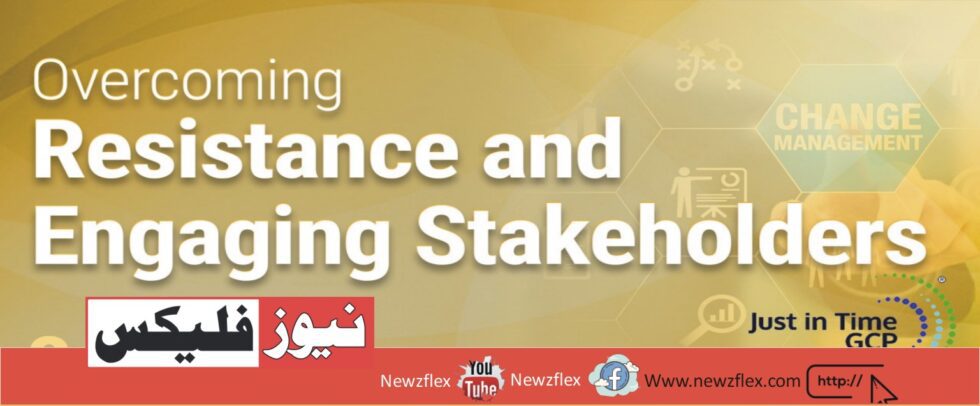
You're facing resistance to project decisions. How can you win over stakeholders who may not agree?
You’re facing resistance to project decisions. How can you win over stakeholders who may not agree?


آپ کو پروجیکٹ کے فیصلوں کے خلاف مزاحمت کا سامنا ہے۔ آپ اسٹیک ہولڈرز کو کیسے جیت سکتے ہیں جو متفق نہیں ہوسکتے ہیں؟
منصوبوں کو منظم کرنے کا مطلب اکثر اسٹیک ہولڈرز کی مزاحمت کا سامنا کرنا ہوتا ہے۔ چاہے یہ بجٹ، ٹائم لائنز، یا تبدیلیوں کے بارے میں ہو، ہر کوئی آپ کے فیصلوں سے اتفاق نہیں کرے گا۔
لیکن اسے رکاوٹ کے طور پر دیکھنے کے بجائے، اسے ان کے ساتھ اپنے نقطہ نظر کو مشغول کرنے، سمجھنے اور ہم آہنگ کرنے کا موقع سمجھیں۔ یہاں ہے کہ آپ کس طرح مزاحمت کو سپورٹ میں بدل سکتے ہیں
نمبر1 : سمجھیں کہ وہ مزاحمت کیوں کرتے ہیں
مزاحمت سے خطاب کرنے سے پہلے، اختلاف کی جڑ تک جائیں۔ اپنے آپ سے پوچھیں: وہ پیچھے کیوں دھکیل رہے ہیں؟ مزاحمت اکثر حقیقی خدشات سے آتی ہے، نہ کہ صرف ضد۔
کیا وہ اپنے کام یا مجموعی منصوبے پر پڑنے والے اثرات کے بارے میں فکر مند ہیں؟ ان کے خدشات سننے کے لیے وقت نکالیں۔ ان کے نقطہ نظر کو سمجھنا ہمدردی کو ظاہر کرتا ہے اور بامعنی گفتگو کی راہ ہموار کرتا ہے۔
نمبر2 : اپنے فیصلہ سازی کے عمل کے بارے میں شفاف رہیں
غیر واضح فیصلے مزاحمت پیدا کرتے ہیں۔ اسٹیک ہولڈرز کو جیتنے کے لیے، اپنے فیصلہ سازی کے عمل کی کھل کر وضاحت کریں۔ آپ نے کن عوامل پر غور کیا؟فیصلے سے پروجیکٹ کو کیا فائدہ ہوگا—اور اس سے بھی اہم بات یہ کہ اس سے انہیں کیا فائدہ ہوگا؟
شفافیت اعتماد پیدا کرتی ہے، اور اعتماد مخالفت کو کم کرنے میں مدد کرتا ہے۔ جب لوگ اس کی وجہ سمجھتے ہیں، تو وہ اس کی حمایت کرنے کا زیادہ امکان رکھتے ہیں۔
نمبر3 : فیصلوں کو بڑی تصویر سے جوڑیں
اکثر، مزاحمت طویل المدتی وژن کی بجائے فوری چیلنجز پر توجہ مرکوز کرنے سے پیدا ہوتی ہے۔ اپنے اسٹیک ہولڈرز کی بڑی تصویر دیکھنے میں مدد کریں۔ انہیں دکھائیں کہ یہ فیصلہ کس طرح طویل مدتی اہداف کے ساتھ مطابقت رکھتا ہے اور وسیع حکمت عملی میں حصہ ڈالتا ہے۔ قلیل مدتی تکلیف کے بجائے مستقبل پر توجہ مرکوز کرنے سے شک کو حمایت میں بدلنے میں مدد مل سکتی ہے۔
نمبر4 : روایتی سوچ کو چیلنج کریں
بعض اوقات، اسٹیک ہولڈرز صرف اس وجہ سے مزاحمت کرتے ہیں کہ وہ چیزوں کو ایک خاص طریقے سے کرنے کے عادی ہیں۔ یہ سوال کرنا ضروری ہے کہ کیا معمول کا طریقہ اب بھی بہترین ہے۔
انہیں یہ پوچھ کر نئے امکانات تلاش کرنے کی دعوت دیں، اگر ہم نے کچھ مختلف کرنے کی کوشش کی تو کیا ہوگا؟ تجسس کی حوصلہ افزائی کریں۔ تازہ خیالات نئے نقطہ نظر کو کھول سکتے ہیں اور مزاحمت کو کم کر سکتے ہیں۔
نمبر5 : چھوٹی جیت تخلیق کریں
سپورٹ حاصل کرنے کا ایک مؤثر طریقہ یہ ہے کہ آپ اپنے فیصلے کو قدم بہ قدم ثابت کریں۔ چھوٹی شروعات کریں۔ فیصلے کو مرحلہ وار نافذ کریں اور واضح نتائج پیدا کریں۔ چھوٹی جیتیں رفتار پیدا کرتی ہیں اور شک کرنے والوں کو حامیوں میں بدل دیتی ہیں۔
نمبر6 : اپنی پسند کی حمایت کے لیے ڈیٹا کا استعمال کریں
ڈیٹا مزاحمت کا سامنا کرنے پر ایک طاقتور ٹول ہو سکتا ہے۔ اپنے فیصلوں کا بیک اپ لینے کے لیے ثبوت—کیس اسٹڈیز، میٹرکس یا ماضی کے پروجیکٹس کی مثالیں لائیں۔ نمبر ایک ایسی کہانی سناتے ہیں جسے نظر انداز کرنا مشکل ہے۔
جب آپ ڈیٹا پیش کرتے ہیں جو پروجیکٹ کے اہداف سے ہم آہنگ ہوتا ہے، تو آپ ایک مضبوط کیس بناتے ہیں اور اسٹیک ہولڈرز کو اپنے انتخاب کے پیچھے منطق کو دیکھنے میں مدد کرتے ہیں۔
نمبر7 : اسٹیک ہولڈرز کو عمل میں شامل کریں
لوگ ان فیصلوں کی حمایت کرنے کے زیادہ امکان رکھتے ہیں جن کی تشکیل میں انہوں نے مدد کی ہے۔ اسٹیک ہولڈرز کو ابتدائی طور پر بات چیت میں مدعو کریں۔
ان کے ان پٹ کی حوصلہ افزائی کریں اور انہیں محسوس کریں کہ وہ فیصلہ سازی کے عمل کا حصہ ہیں۔ جب لوگ محسوس کرتے ہیں کہ سنا اور قابل قدر ہے، وہ حتمی انتخاب کی حمایت کرنے کے لیے زیادہ تیار ہوتے ہیں، چاہے یہ ان کی اصل ترجیح نہ ہو۔
نمبر8 : پرسکون اور پیشہ ور رہیں
مزاحمت سے نمٹنے کے دوران دفاعی بننا آسان ہے، لیکن یہ عام طور پر صورتحال کو مزید خراب کر دیتا ہے۔ پرسکون اور پیشہ ور رہیں، دلائل کی بجائے حل پر توجہ دیں۔ یہ ظاہر کرنا کہ آپ مکالمے کے لیے کھلے ہیں، تصادم کے لیے نہیں، اسٹیک ہولڈرز کو تعمیری انداز میں مشغول ہونے کی ترغیب دیتا ہے۔
باٹم لائن
مزاحمت کو حمایت میں بدلنے کے لیے صبر، مواصلت اور دوسروں کے خدشات کو سمجھنے کی خواہش کی ضرورت ہوتی ہے۔ سننے، فیصلوں کو واضح طور پر بیان کرنے، اور اسٹیک ہولڈرز کو عمل میں شامل کرنے سے، آپ اختلاف رائے کو نتیجہ خیز گفتگو میں تبدیل کر سکتے ہیں۔ مزاحمت پراجیکٹ مینجمنٹ کا ایک فطری حصہ ہے، لیکن اسے ترقی کی راہ میں رکاوٹ نہیں بننا چاہیے۔
اس کے بجائے، اسے نئے آئیڈیاز کو دریافت کرنے اور پوری ٹیم میں صف بندی کو مضبوط کرنے کے موقع کے طور پر استعمال کریں۔ آخر میں، مزاحمت صرف قابو پانے کی چیز نہیں ہے- یہ مضبوط روابط بنانے، تعاون کو فروغ دینے اور بہتر نتائج حاصل کرنے کا موقع ہے۔








